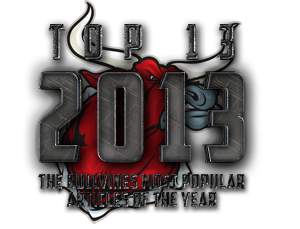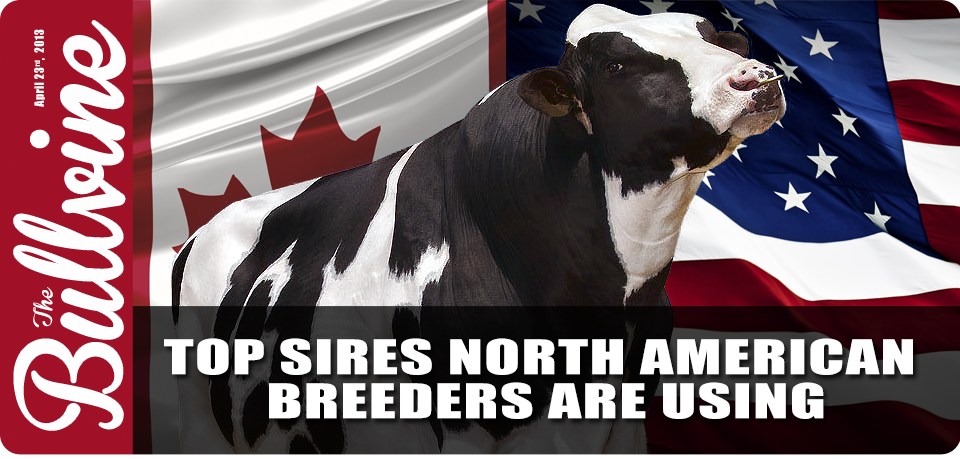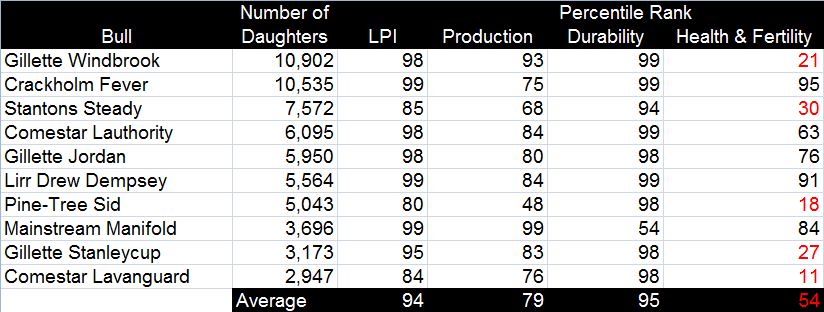
Milking Daughters
In fact, in addition to the sons a bull has enter AI, it is the number of milking daughters of a bull that determines the contribution he will have on the breed. The Bullvine decided to investigate the female registrations by sire to determine which bulls breeders are actually using.
Population geneticists tell us that about 25% of the improvement in a population comes from the sires that produce the milking daughters. By comparison the contribution from the sires of AI young sires is 43%, the contribution from the dams of AI young sires is 25% and the contribution from the dams of the milking females is 7%. Even though the sires of milking daughters contribution is not the most important factor in an Al breeding population, it is the most important factor that breeders have control of in their herd.
Canada – 2012
The ten sires with the most registered daughters in 2012 in the Canadian Holstein Herdbook accounted for 23% of all female registrations. All ten sires were daughter proven and all listed in Table 1.
Table 1 Sires with the Most Registered Canadian Daughters (2012)
Every sire has his own merits and limitations. In our analysis the Bullvine decided to consider the Percentile Rank (%RK) each sire has for each of LPI and its three major components – Production, Durability and Health & Fertility. The ranges in and overall averages for %RK for these ten sires are very revealing. Even though these sires are 94%RK for LPI it can be seen that Canadian breeders put more emphasis on Durability (think Conformation) at 95%RK, moderate emphasis on Production at 79%RK and little emphasis on Health & Fertility at 54%RK.
Only one sire is below 94%RK for Durability and only two sires are below 75%RK for Production. However a very limiting factor to genetically advancing Canadian Holsteins is the fact that only four sires, Fever, Dempsey, Manifold and Jordan, are over 75%RK for Health and Fertility. The fact is that little attention is being paid to Daughter Fertility when breeders use sires. That should concern us all.
What’s Happening in 2013
Holstein USA provides on its website a report called “High Registry Activity by Bull”. The report is updated daily and is for the most recent two week time period. The following is the report for April 22, 2013 (registrations April 08 to April 19).
Table 2 Sires with the Most USA Daughters (April 2013)
It is worthy of note that Mogul, McCutchen, Gold Chip and Supersire are all genomically evaluated bulls without any daughters included in their indexes. The other six sires are all daughter proven.
The Bullvine does not have the Percentile Rank tables for the USA bulls so the numbers in Table 2 are their actual index numbers. However the results are very similar to the top ten Canadian sires in 2012. TPI, PTAT, UDC and FLC are all relatively high index numbers on average. And the indexes for Net Merit, SCS and Milk are moderate to high. However standing out as being below average is Daughter Pregnancy Rate (DPR). So USA breeders, like their Canadian counterparts, are also not placing emphasis on a breed problem – fertility.
The Numbers Tell the Story
One question we had was “How much are genomic sires being used?”. Table 2 shows four genomic sires in the top ten in the USA. In fact in the top thirty most used American sires in 2013 there are eleven genomic sires. That compares to three in the top thirty in Canada in 2013. Breeders in the USA are making much more use of sires with genomic evaluations than Canadian breeders are.
The proof of the pudding is in the eating. The sires that advance a population are the ones that breeders use not the ones that top the ranking lists.
The Bullvine’s assessment on the sires breeders are currently using is:
- Production – Maintain the current amount of emphasis
- Type / Durability – the emphasis can be diminished
- Health & Fertility – the emphasis needs to be increased
The Bullvine Bottom Line
Given that many breeders tell The Bullvine that they wish to genetically improve health and fertility in their herds, it is time for breeders and AI organizations to become much more discriminating in these areas. Young sires entering AI will need to genomically rank in the top 25% of the population for DPR or DF. Many sires currently getting use in North America do not measure up for health and fertility. The genetic merit of sires selected and used in the coming years needs careful re-consideration.
Indexes are like having a compass. First you have to know where you want to go. Then you have to USE the information or you could still wind up lost.
Get original “Bullvine” content sent straight to your email inbox for free.
[related-posts-thumbnails]




















Leave a Reply
You must be logged in to post a comment.